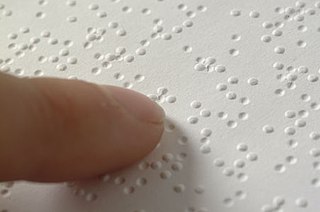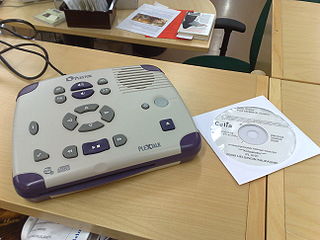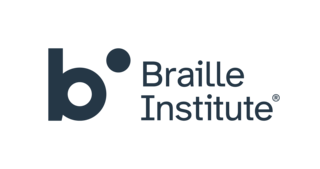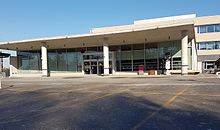
Braille is a tactile writing system used by people who are visually impaired, including people who suffer from low vision, blindness, or deafblindness. It can be read either on embossed paper or by using refreshable braille displays that connect to computers and smartphone devices. Braille can be written using a slate and stylus, a braille writer, an electronic braille notetaker or with the use of a computer connected to a braille embosser.
Perkins School for the Blind, in Watertown, Massachusetts, was founded in 1829 and is the oldest school for the blind in the United States. It has also been known as the Perkins Institution for the Blind.

Accessibility is the design of products, devices, services, vehicles, or environments so as to be usable by people with disabilities. The concept of accessible design and practice of accessible development ensures both "direct access" and "indirect access" meaning compatibility with a person's assistive technology.
The Royal National Institute of Blind People (RNIB) is a UK charity offering information, support and advice to almost two million people in the UK with sight loss.
Service and supports for people with disabilities are those government or other institutional services and supports specifically provided to enable people who have disabilities to participate in society and community life. Some such services and supports are mandated or required by law, some are assisted by technologies that have made it easier to provide the service or support while others are commercially available not only to persons with disabilities, but to everyone who might make use of them.

The Canadian currency tactile feature is a feature on the Canadian Journey and Frontier series of Canadian banknotes to aid people who are visually impaired to identify the notes. The feature indicates the banknote denomination in the upper left corner of the face side of the bill using a series of raised dots. It was suggested by Bruno Thériault, an administrator for the Canadian National Institute for the Blind, and designed by Susan Lederman, a professor of psychology at Queen's University.
The American Foundation for the Blind (AFB) is an American non-profit organization for people with vision loss. AFB's objectives include conducting research to advance change, promoting knowledge and understanding, and shaping policies and practices.
Visual impairment, also known as vision impairment, is a medical definition primarily measured based on an individual's better eye visual acuity; in the absence of treatment such as corrective eyewear, assistive devices, and medical treatment– visual impairment may cause the individual difficulties with normal daily tasks including reading and walking. Low vision is a functional definition of visual impairment that is chronic, uncorrectable with treatment or conventional corrective lenses, and impacts daily living. As such low vision can be used as a disability metric and varies based on an individual's experience, environmental demands, accommodations, and access to services. The American Academy of Ophthalmology defines visual impairment as the best-corrected visual acuity of less than 20/40 in the better eye, and the World Health Organization defines it as a presenting acuity of less than 6/12 in the better eye. The term blindness is used for complete or nearly complete vision loss. In addition to the various permanent conditions, fleeting temporary vision impairment, amaurosis fugax, may occur, and may indicate serious medical problems. The abbreviation VIP is sometimes used for Visually Impaired Person, Persons or People.

Digital accessible information system (DAISY) is a technical standard for digital audiobooks, periodicals, and computerized text. DAISY is designed to be a complete audio substitute for print material and is specifically designed for use by people with "print disabilities", including blindness, impaired vision, and dyslexia. Based on the MP3 and XML formats, the DAISY format has advanced features in addition to those of a traditional audio book. Users can search, place bookmarks, precisely navigate line by line, and regulate the speaking speed without distortion. DAISY also provides aurally accessible tables, references, and additional information. As a result, DAISY allows visually impaired listeners to navigate something as complex as an encyclopedia or textbook, otherwise impossible using conventional audio recordings.
In Canada, Easter Seals is a group of charitable organizations which supports the development and advancement of people who are living with different types of disabilities. Founded in 1922 by a group of Rotary Clubs, it sought to emulate the success of the American Easter Seals program.

The Guide Dogs for the Blind Association, known colloquially as Guide Dogs, is a British charitable organisation founded in 1934. The Association uses guide dogs to help blind and partially blind people. The organisation also participates in political activism for the rights of those with vision impairments.
The National Library Service for the Blind and Print Disabled (NLS) is a free library program of braille and audio materials such as books and magazines circulated to eligible borrowers in the United States and American citizens living abroad by postage-free mail and online download. The program is sponsored by the Library of Congress. People may be eligible if they are blind, have a visual disability that prevents them from reading normal print, or a physical disability that keeps them from holding a book. Library materials are distributed to regional and subregional libraries and then circulated to eligible patrons. In total there are 55 regional libraries, 32 subregional libraries, and 14 advisory and outreach centers serving the United States and its territories: the District of Columbia, Puerto Rico, the U.S. Virgin Islands, and Guam.

The Associated Services for the Blind & Visually Impaired (ASB) is a private non-profit organization in Philadelphia, Pennsylvania. It assists those living with vision loss to achieve independence through education, support services to advance necessary skills, and community connections. ASB collaborates with local, regional and national partners to provide additional resources and opportunities to clients.
A sighted child who is reading at a basic level should be able to understand common words and answer simple questions about the information presented. They should also have enough fluency to get through the material in a timely manner. Over the course of a child's education, these foundations are built on to teach higher levels of math, science, and comprehension skills. Children who are blind not only have the education disadvantage of not being able to see: they also miss out on the very fundamental parts of early and advanced education if not provided with the necessary tools.

The Braille Institute of America (BIA) is a nonprofit organization with headquarters in Los Angeles providing programs, seminars and one-on-one instruction for the visually impaired community in Southern California. Funded almost entirely by private donations, all of the institute's services are provided completely free of charge. The organization has seven regional centers: Anaheim, Coachella Valley, Laguna Hills, Los Angeles, Riverside, San Diego and Santa Barbara, as well as outreach programs at more than 200 locations throughout Southern California. It is a member of the Braille Authority of North America.
Warwickshire Vision Support is a registered charity in England providing rehabilitation services for adults with visual impairments to enable them to live independently.
Mitra Jyothi established in 1990, is a charitable trust registered under Indian Trust Act based in Bangalore. Its aims to support the visually impaired through various programs it offers. These programs include Talking Book Library, Computer Training Center, Independent Living Skills, Braille Transcription Center and Job Placement. It received State Award in 2010 from the Directorate of Disabled Welfare and Senior Citizens, Government of Karnataka for its exemplary service for persons with disabilities. Mitra Jyothi is also a member of the DAISY Forum of India (DFI). DFI is a forum of Not for profit organizations from India who are involved in production of books and reading materials in accessible formats for persons who cannot read normal print.
The Council of Schools and Services for the Blind (COSB) is a consortium of specialized schools in Canada and the United States whose major goal is improving the quality of services to children who are blind and visually impaired.
Mae Brown (1935–1973) was the second deaf-blind woman and the first deaf-blind Canadian to earn a university degree. She graduated from the University of Toronto Scarborough in 1972.
Darleen Bogart is a Canadian Braille literacy advocate. She is a founding member of Canadian Braille Authority and served as its president. She was appointed an Officer of the Order of Canada in 2017.









